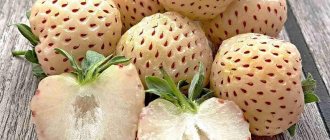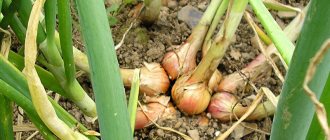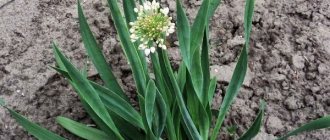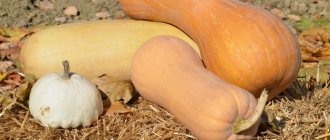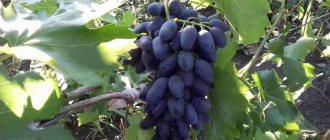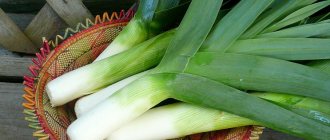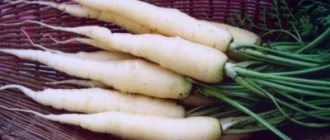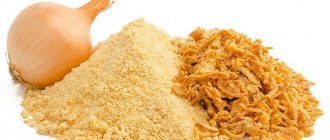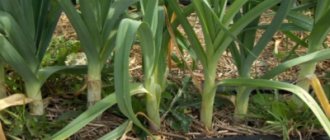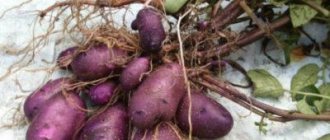Leeks are a slightly unusual variety that are gaining popularity every year. It does not produce the usual onions, but forms a thick, bleached lower part of the stem with an excellent delicate taste, which is used for food. The leaves are good for preservation and marinades. The Columbus variety pleases with its tenderness and piquant taste.
| Maturation | Type | Color | Life form | Taste |
| Mid-early | Leek | Green | annual | Mild-sharp |
Description of the species, origin and development
Externally, leeks differ from many of their “brothers”: in the first year of life, leaves and a thick white stem actively grow.
It is this that is a valuable part of plants of this species of the onion family. Asia is considered the homeland of leeks; the plant was brought there in its wild form from the Mediterranean, where it was known 4 thousand years ago. Since then, leek has been cultivated everywhere, including in all vegetable growing zones of Russia.
Varieties of leeks
Leeks have dozens of varieties that differ in terms of ripening - early, medium and late.
Attention! Winter varieties with a growing season of 180-200 days are not suitable for growing in northern latitudes; they do not have enough time to ripen.
Early
They are considered the most productive and ripen quickly, already at the end of summer. A characteristic feature is a thin stem with a lightened part of 30-45 cm. Ripens 90-140 days after germination. Weight on average 300 g.
Varieties that ripen in summer include:
- Columbus . A variety of Dutch selection, stress-resistant, tolerates temperature changes and cold well. Fruitful, early ripening. From germination to harvest – 85 days. The plant is powerful, the volume of cut greens reaches 400 g. The leaves are waxy, flat, and can reach a height of 80 cm. Columbus leeks are stored for a long time without losing their taste and commercial qualities. Recommended for universal use. When grown, it does not require repeated hilling to whiten the productive part.
- Vesta . Domestic variety. Begins to ripen 120 days after sowing. Productivity is about 6 kg per m², plant length 100-140 cm, weight 270-300 g. Universal in use, resistant to diseases. Needs hilling. In regions with cool climates, it is recommended to grow seedlings.
- Winner . The plant is of medium height, leaves with a slight waxy coating, the length of the bleached part is 20-25 cm, the weight of edible greens is 200-230 g. You have to wait about 135 days for the harvest. It has a delicate, semi-sharp taste. Frost-resistant, suitable for cultivation in northern regions.
Medium ripening
They ripen in autumn, their “life” is 150-160 days. They have larger dark leaves that are tightly located on the false stem. Mature plants can withstand temperatures as low as -15°C. Shelf life – no more than 2.5 months.
Of these varieties, the following are especially distinguished:
- Casimir. Developed by Russian specialists, recommended for use throughout Russia. The variety is valued for the high quality of the bleached part of the plant. The shoots are tall, the leaves are located almost vertically, and have a dark green color. Demanding on moisture, loves feeding. The period from complete germination to harvesting is approximately 180 days. About 4 kg of product per 1 m². It is preferable to grow as seedlings.
- Elephant's trunk . It has a long, massive stem, which is how it got its name. It has high consumer qualities and a sweetish taste. The height of the plant is 60-70 cm, the weight of the productive part is 150-200 g, 4-4.5 kg of product is collected from 1 m². The variety ripens in 140-150 days. Not afraid of frost, resistant to major diseases. Can be stored for 2-3 months.
- Elephant. It is distinguished by a record length of 1.5 m and high quality of the bleached part. The edible mass exceeds 300 g. The harvest can be harvested after 135-145 days. They are grown by seedlings; hilling is required.
Late ripening
They ripen for more than 6 months, which is why they are also called winter varieties. They have dark, densely spaced leaves with a bluish, waxy coating, and are characterized by a short stalk and slow development. Cold-resistant, harvesting in the southern regions occurs from November to April.
These varieties include:
- Alligator. Productivity is high, weight up to 300 g, disease resistant, good shelf life. The taste is delicate with a slight aroma of garlic. Ripening period – 200 days.
- Karantansky. Developed in the USSR, it has excellent characteristics: weight 250-325 g, 175 days to ripening, yield - 2.5 kg per m², slightly spicy, pleasant taste. Caranta leeks are ready for harvesting after 200 days. In cold regions it is grown exclusively by seedlings.
- Bandit. The variety is valuable for its resistance to unfavorable climates. The leaves are dark green in color with a bluish tint. They are harvested at the end of October; in the south it is practiced to overwinter the Bandit in the garden, followed by harvesting in the first spring months. The yield is 3-4 kg per m².
- Autumn giant. A Dutch variety of impressive size with a thick white stem. Maturation is extended over 1.5 months. If stored properly, it can delight you with its greenery all winter long.
Chemical composition, trace elements, vitamins and beneficial properties
Leeks have a unique property: during storage in the bleached part of the plant, the level of ascorbic acid almost doubles. And the high content of magnesium, iron, sulfur, phosphorus, potassium and calcium makes leek the most valuable product on our table. Essential oil, nicotinic acid, thiamine and carotene give onions healing properties.
Ripening time and yield
Early-ripening varieties will be ready in 90-140 days, mid-ripening or autumn varieties can be harvested 150-160 days after germination, and the harvest of winter varieties will begin after 180-200 days.
The yield of leeks varies depending on the variety. The average weight of the product is 16-20 tons per 1 hectare of land. Climatic conditions and quality of care when growing leeks directly affect the volume, presentation and keeping quality of the crop.
Disease resistance
Leeks are more resistant to major diseases of the Allium genus than onions. In particular, relative resistance to peronosporosis is noted.
Characteristics of the bulb, description of appearance, taste
Leeks are valued for their long white bulb, which is also called a false stem, or “leg” - it is much more flavorful than that of onions. Sweetish-spicy, delicate and delicate flavor is ideal as a seasoning for soups, salads, vegetable and meat stews, and many other dishes.
After germination, leek seeds look like tiny sprouts that have just sprouted for two months. But after a few months the plant amazes with its size: the height reaches 1.5 m, the false stem can weigh 400 g.
The leaves resemble garlic, the root system is well developed, but is much smaller in volume than the above-ground part of the onion.
Reference. The “leg” of each variety has its own size. To increase it artificially, the base of the stem is not allowed to turn green; for this, the onion is hilled.
For which regions is it best suited and what are the climate requirements?
According to the results of variety trials, the following varieties are suitable for central Russia: Elephant, Vesta, Kazimir, Columbus, Karantansky.
Leek varieties for Siberia and other cold regions: Vesta, Columbus, Pobeditel.
But the southern regions can take advantage of the entire varietal range of leeks.
The best taste is achieved in regions with a mild and humid climate. The seeds germinate at temperatures around 3-4°C, but enter the growth phase at a minimum temperature of 15-20°C, although leeks can withstand temperatures down to -15°C.
Along with its high light requirements, this plant exhibits sensitivity to lack of water and requires frequent watering.
Columbus
An early, strong crop variety that produces high yields. You can start harvesting after 85 days. The bleached part is characterized by a height of 20 to 30 cm, it is thick and juicy. Ripens quickly, the stem is tender and not very dense. The bulb is practically invisible, the taste is slightly pungent, pleasant for use in salads. Suitable both dried and canned.
"Columbus" is unpretentious to soils, forms a light part with virtually no hilling. The crop needs regular watering and moderate feeding. It cannot be stored for a long time, it begins to germinate. One bag of seeds costs from 30 rubles.
Main advantages and disadvantages
Advantages:
- cold-resistant;
- resistant to diseases;
- low calorie;
- a source of iron, calcium, magnesium, B vitamins, as well as PP and E.
Flaws:
- after consumption, like garlic, it gives a specific smell from the mouth;
- may cause flatulence;
- Harmful for people suffering from ulcers or stomach inflammation.
What is the difference from other varieties:
- edible at different stages of development;
- grows leaves until late autumn;
- During storage, the content of ascorbic acid increases.
Beneficial properties for the human body
Regular consumption of leeks helps in the treatment and prevention of the following diseases and conditions :
- atherosclerosis;
- avitaminosis;
- cardiovascular diseases;
- rheumatism;
- gout;
- nervous exhaustion;
- sleep disturbance;
- diseases of the biliary tract;
- decrease in hemoglobin;
- memory impairment;
- metabolic disorders.
Recommended by nutritionists, since 100 g of onion contains only 35 kcal. It is actively used in cosmetology as masks, peeling, hair growth stimulator and dandruff reliever. Strengthens the nail plate, treats sunburn and calluses.
Diseases and pests
The list of diseases that can affect leeks, including the Elephant Trunk variety, is not so long, but even they are enough to destroy the crop and destroy the plant. Here are the main ailments that this agricultural crop suffers from:
- Viral mosaic – it is impossible to get rid of this disease. The carrier is aphids. Therefore, for prevention purposes, it is necessary to get rid of these pests. If the onion is already affected, then it will have to be removed from the garden along with the roots. The virus appears as yellow spots of various shapes scattered throughout the onion stem. The growth of the leek stops and it dies.
- Leaf rust is a fungal disease. The leaves become covered with yellow and orange swellings. And all because of colonies of fungal spores that have the ability to multiply quickly. As a result, the foxes darken and dry out. The affected leaves are removed, and the surviving ones should be sprayed with a solution of Fitosporin or copper preparations.
- Downy mildew . The causative agent of the disease is a fungus; the disease manifests itself as white spots on the plant, which increase in size over time. Diseased sprouts are pulled out along with the root; surviving ones can also be saved by treating them with copper oxychloride or Fitosporin.
- Aphids and onion flies. Elephant trunk leeks can also be attacked by pests, the most dangerous of which are aphids and onion flies.
- As mentioned above, aphids carry a dangerous disease - viral mosaic. In the case of Elephant Trunk, as an early type of leek, it is best processed using folk methods. For example, infusion of tobacco dust. To do this, mix 200 g of tobacco and 20 g of any soap. They are bred in a bucket of water.
- The fight against onion fly is carried out in a similar way. You can also pollinate the plant with ground pepper or water the beds with ash diluted in water. Otherwise, the fly will plant its larvae on the leaves of the plant, and they, in turn, gnaw out the shoots, which leads to their complete damage. The onion fly does not tolerate plants such as celery and carrots. Experienced gardeners know this and sow these plants next to leeks.
Features of planting and growing
There are two ways to grow leeks:
- in regions with long summers, you can use seeds or seedlings;
- in colder regions, only seedlings will do.
Preparing for landing
Before planting, seeds are dipped in hot water, then immediately in cold water, then kept in damp gauze for several days until germination.
Reference. Leek seeds are stored in a warm, dry place for up to 3 years without losing their quality.
Soil requirements
First, prepare the soil: fertilizing and moistening it is the key to a good leek harvest. The choice of landing site is also important. Onions are planted in light loamy areas where cabbage, peas or other legumes grew the previous year.
Attention! It is strictly forbidden to plant leeks in a bed where onions previously grew - this can cause the stem to rot.
Dates, scheme and rules of planting
At the end of February, they are sown in pots for growing seedlings, in mid-April the seeds are planted in greenhouses, and at the end of April - under film in the garden bed. Place the seeds in rows, with a distance of 5 cm between them. Place them at a depth of no more than 1 cm.
Features of cultivation
Before emergence, the air temperature should be around 23°C, then not exceed 17°C for about a week, after and throughout the growing season the optimal temperature for seedlings is 21°C. High temperatures during the period of growing seedlings will lead to the early formation of flower shoots, which is unacceptable.
Nuances of care and watering regime
Seeds are sown as rarely as possible to prevent picking. Leek seedlings do not tolerate it well and are delayed in development for a long time.
It is recommended to trim onion leaves twice a month, leaving 10 cm, this will improve the growth of the root system and contribute to the thickening of the stem.
Regular and abundant watering is the basis for the full development of leeks . During dry periods, watering must be done every evening. The ground should be moist, without flooding.
Loosening the soil and weeding
You need to loosen and hill up the plant every week, adding fresh soil to the stem. Weeding is done as needed, at least three times a month.
Top dressing
Some gardeners prefer not to feed leeks at all. However, if you want to get a high-quality harvest, feed the plants once a month, alternating organic fertilizers with mineral ones.
Of the mineral root dressings, the best mixture is considered:
- water 5 l;
- potassium 15 g;
- "Superphosphate" 20 g;
- ammonium nitrate 15 g.
Ready-made medications, for example, Vegeta, are also recommended. It is diluted for watering 1 tbsp. l. products in 5 liters of water.
The recommended organic material for leeks is mullein or bird droppings. Cow manure is diluted in water 1:10, bird droppings - 1:20. Fertilizing must be left in place for at least 12 hours.
Important! If the leek leaves become smaller and the tops turn yellow, then the soil has weak acidity. For better plant growth, it needs to be optimized to a pH level of 5-6.
Disease and pest control
There are a number of pests that are difficult to control on site.
Sucking parasites such as aphids, mites and bulb flies can destroy plants themselves or through viruses and bacteria carried on their legs. For example, mosaic is a virus carried by aphids. It is impossible to fight it; prevention is needed. To do this, use wood ash, dry mustard or ground red pepper: sprinkle them between the rows before loosening. If pests have attacked a large area, use the insecticides “Iskra”, “Tanrek” or “Alatar” - these drugs successfully fight against aphids, mites, whiteflies and bulb flies in the garden. The pyrethroid drug “Vantex” can be used as a preventive measure in the fight against bulb fly.
If psyllids are found on leeks, the affected areas are sprayed with Karate Zeon for protection. To consolidate the effect, the procedure is repeated after two weeks.
How to grow from seeds?
It is best to plant Columbus in the southern regions; in the northern parts the variety does not always take root.
When planting seeds, the following rules should be observed:
- The seeds are treated: first they need to be placed in hot water for 30 minutes, then immediately in cold water for half an hour.
- Seed preparation is also carried out immediately before sowing: the grains are placed in a wet cloth for several days. After their germination, you can plant the resulting seedlings in the ground.
All these manipulations are carried out at the end of February or beginning of March.
Depending on the region. For this:
- Take a box or pot where germinated seeds are sown to a depth of 2 cm.
- After which the container is covered with film.
- As soon as the first shoots appear from the soil, the film can be removed.
- After this, you will have to constantly monitor the room temperature, which should not fall below 18 degrees. Watering is carried out several times a week.
Advice from experienced gardeners
To be able to grow leeks on your plot on the first try, use the recommendations of experienced gardeners:
- If the root of the plant was damaged during transfer to open ground, trim the leaves. This will direct forces to restore the root.
- Before transplanting the seedlings, the roots can be coated with a mixture of cow dung and clay in equal proportions. The plant will settle into its new location faster and more firmly.
- The deeper the grooves when planting seedlings, the longer the edible stem of the leek will be.
- When storing onions fresh, check them regularly. Remove dried, yellowed stems, otherwise you risk losing the entire harvest.
Seedling care
After the seeds have sprouted, the gardener needs to accustom the young plant to a drop in temperature. To do this, in the first days after removing the film, the room temperature at night must be at least 18 degrees. After the first week it can be lowered by a few degrees. Maximum minimum + 7-9 degrees.
Leek seedlings
This will help to transplant the plant into the ground earlier. In spring, the weather is changeable, so that a sharp cold snap does not destroy the plant, it is prepared in advance. Moreover, before planting, the seedlings can be placed for several days next to the garden bed, where they will further develop.
If seedlings are grown in winter, the gardener needs to increase the daylight hours for the plant. This can be done either artificially using special lamps or naturally by moving the boxes to the place where the light falls.
Reviews of leek varieties
Professionals and novice gardeners approve of many varieties of leeks. Many people try to grow it for the first time and are satisfied with the result:
Elena, Moscow: “Bandit is an excellent leek, I grew it for three years in a row until the seeds ran out. He is squat, the leg is not long, like, for example, Karantansky and Kazimir, but plump. This year I bought seeds again and will grow them again.”
Angelina, Veliky Novgorod: “Last season I planted leeks Elephant Trunk. I recommend. The onion turned out good, as usual. Today I brought 2 pieces. from the basement in the garage. It is perfectly stored, the little green one sticks out in a bucket, sprinkled with sand and sawdust.”
Stepan, Novopolotsk, Belarus : “A lot depends on the type of leek. I grow summer varieties. For example, Columbus, which, according to reviews, is usually not stored. And I store it almost until May. All storage methods require specific conditions and are not suitable for amateur use. I retain up to 90% without much effort. The main thing is that after digging, the onion gives up excess water, which is responsible for the onset of rotting.”
Harvest and storage
The first harvest is harvested when the first leaves grow . The harvest is completely harvested before the first frost in August or early September. Dig up the base of the onion and cut off the roots. Store in a vertical or semi-inclined position, covered with sand in the basement. This way it is stored for 5-6 months.
The leaves retain freshness quite well after harvesting and become more juicy, while accumulating vitamin C. They are stored in an open plastic bag for up to 2 months. And if the leek is cooled and then packed in a plastic bag, it can be stored in the refrigerator for quite a long time.
Here is a detailed article about storing leeks.
Botanical description
The plant reaches 0.4-0.9 m in height. In the first year of life, the culture forms a powerful root system. The leaves are flat, long (0.4-0.6 m), greenish-blue in color, arranged in a fan. The flowers are small, form an umbrella, and are whitish or pink. The bulb is elongated, with a diameter of 0.02-0.08 m and a length of 0.1-0.12 m. The white basal part of the plant is eaten. Propagated by seeds, which remain viable for up to 2-4 years.
Currently, 3 varieties are cultivated: winter, autumn and summer leeks. The harvest season is April-May and September-December.
Pearl onions are a cold-resistant crop that prefers abundant watering (without waterlogging), high-humus floodplain or loamy soils.
Mid-season varieties
Mid-season (autumn) varieties can be harvested in the middle zone in the first half of October. Their legs are quite thick and of medium length. These varieties are more numerous compared to the earlier ones. Varieties: Columbus, Tango, Casimir, Summer Breeze, Winner.
Kazimir
A productive German variety, very demanding of moisture and nutrition. Tall, leaves grow almost vertically. The leg is 22-26 cm long, about 3-3.5 cm in diameter, the taste is sweet with a slight bitterness. Well kept.
Columbus
A Dutch cold-resistant variety that requires minimal care. The plant is tall, up to 140 cm, the leaves are raised and densely spaced. The length of the leg is up to 18 cm, the diameter on average is from 3 to 6 cm, the weight can exceed 300 g, the taste of the white part of this onion is excellent.
Summer breeze
A productive domestic variety. The plant is tall, powerful, with large raised leaves. The length of the leg is up to 25 cm, thickness up to 4 cm, weight 200-250 g, the taste of the white part is semi-sharp.
Winner
Frost-resistant reliable variety. Medium height, raised shower. The stem is up to 20 cm, diameter is about 3.5 cm, weight is up to 200 g, the taste is delicate, almost not spicy. The leaves are almost as tasty as the stem.
Tango
Popular Czech variety. Plants are medium-sized, leaves are semi-vertical. The leg is short (up to 12 cm), but plump (up to 5 cm), weight 200-250 g. The taste of the leg is semi-sharp.
When to collect?
Since the variety Elephant Trunk is an early-ripening variety of leek , it ripens by September. Collection is carried out by digging onions from the ground. The roots need to be cut off without touching the leaves, as they will dry out quickly. The root part is carefully cleaned of any remaining soil.
It is necessary to ensure that lumps do not fall on the greenery of the crop. After this, diseased and damaged onion plants are sorted.
The Elephant Trunk variety has recently become increasingly popular. However, it is worth remembering that without proper care of the crop, good results cannot be achieved. It will take a lot of effort to get onions grown with your own hands on your dinner table.
Cosmetological properties
Leeks have the following cosmetic properties:
- accelerates hair growth (when rubbed into the scalp);
- eliminates unwanted pigmentation on the face, soothes irritated skin after sunburn, prevents the formation of blisters, relieves redness, strengthens nails (masks based on onion stems ground into a homogeneous mass);
- treats calluses (apply baked onion to the problem area).
When consumed regularly, raw leeks help prevent cystitis. The product is especially useful for men, as it serves as a powerful aphrodisiac. The vegetable contains an important sex hormone - androsterone, which enhances the energy and potential of the strong half of humanity.
Leek juice has antiseptic and bactericidal effects. Increases the effectiveness of drug treatment of inflammatory diseases (bladder, arthritis and gout).
Step-by-step instructions for growing
Seedling method
The Elephant variety can only be grown by seedlings . This is due to its long growing season (6-7 months). For subsequent calculations, the age of the seedlings from sowing the seeds to planting them in the ground is used - 60 days and the date of planting in the middle zone - mid-May. Final graph:
- sowing seeds for seedlings - mid-March;
- rooting seedlings into the ground - mid-May;
- The final harvest is early October.
When are seeds sown in different regions of Russia?
Sowing seeds for seedlings is carried out two months before planting the seedlings in the ground. In turn, leek seedlings are planted in the ground:
- North Caucasus and Crimea - in the first half of April;
- Chernozem region - end of April;
- middle zone - mid-May;
- Siberia and the Urals - end of May, beginning of June.
Preparation
Any purchased soil with a neutral (not acidic) reaction is suitable
for sowing onion (nigella) seeds . Before use, it is filled with a complex of mineral fertilizers with a full composition NPK (nitrogen, phosphorus, potassium) in the proportion of one tablespoon of fertilizer per bucket of substrate.
When purchasing seeds, please note that they remain viable for 3-4 years. Purchased seeds usually have already undergone pre-sowing preparation. This will be indicated by a brightly colored shell.
If this is not the case or the seeds are your own, the following operations are performed:
- Calibration The seeds are poured into a glass of water. After 15-20 minutes, low-quality seeds will float to the surface and are thrown away. In the future, only those that remain at the bottom are used.
- Calibrated seeds are pickled in a slightly pink solution of potassium permanganate for 15-20 minutes, after placing them in a gauze bag. After this, the seeds are washed with running water.
- To speed up the germination of seeds, they are soaked for 2-3 days until they swell. After this, seedlings appear in about a week.
Circuit and technology
When planting, leek seeds (nigella) are buried no more than 1 cm . When sowing in flat boxes, the distance between seeds should be 4-5 cm. But it is preferable to use separate cups or cassettes to avoid painful picking.
Seedling care
The optimal temperature for germination is 22-24 °C. After emergence, you can limit yourself to a range of 18-20 degrees during the day and 10-15 at night. Although leeks are a southern plant, they easily tolerate temperature changes. For its development it is only necessary that the temperature does not fall below +15 °C.
But leeks need light.
Attention!
Seedlings must be placed on the sunny side and, if necessary, illuminated with phytolamps.
The soil under the seedlings must be kept moist . At the same time, when watering, you should avoid getting water on the plants themselves - this can provoke fungal diseases.
When the seedlings outgrow, they are trimmed to a height of 8-10 cm.
Moving to open ground
At the age of about 60 days (from sowing), the seedlings are planted in open ground. In this case, the finished seedlings should have three to four leaves and a stem diameter of 5-8 mm .
Before planting, the tops of the leaves are cut to 1/3 of the length (but not shorter than 7-10 cm). To ensure that the bleached part has maximum length, the stem is regularly buried during the growing process. To do this, first the seedlings are planted in grooves (furrows), which are gradually covered with soil as the plants grow.
Subsequently, the plants are hilled. In order for there to be enough soil for this procedure, the row spacing must be wide enough.
As a result, the seedling rooting scheme looks like this :
- the initial depth of the furrows is 15-20 cm (shovel bayonet);
- row spacing 50 cm;
- the distance between plants in a row is 15-20 cm.
Attention!
Already when planting, the plants are buried 3-5 cm from the previous level.
Further care
Further care when growing leeks consists of three mandatory procedures - weeding, loosening and hilling. They can be combined. First, the groove is gradually filled in , then the stem is covered by hilling. This is done 2-3 times during the season.
Watering onions is carried out 1-2 times a week in the absence of rain along the grooves between the rows.
There is a misconception that onions do not need feeding. Modern varieties of all crops are created with intensive technologies in mind, which involve the use of mineral fertilizers. The easiest way is to use a full complex of NPK (nitrogen, phosphorus, potassium) mineral fertilizers. Elephant must be fed with this fat 4 times per season with an interval of one month, starting from planting.
Article on the topic
Everything about growing leeks in open ground.
Is it possible to grow without seedlings?
Early varieties of leeks can be grown using the seedless method only in the south. An elephant with a growing season of up to 200 days, even in the south, will not meet this deadline. It seems irrational to use greenhouses for growing this crop .

